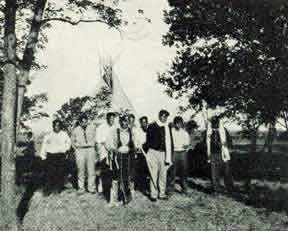By RICHARD EVANS SCHULTES
Page 1 [1] | Page 2 | Page 3 [2]
Intoxication from peyote is singular in that consciousness is never lost, control of the limbs is maintained, a feeling of well-being is experienced, no urge to commit any act of violence is induced, and rarely are there uncomfortable after-effects. The question as to whether peyote is habit-forming is still unsettled, but observations tend to suggest that it is not. It is not used habitually by the Indians.
To the Indian, peyote is the greatest of all medicines. It is used in the ceremony and in daily life as a therapeutic agent. It is thought to give health and longevity; cleanse body and soul; be good for snake bites and scorpion stings; cure colds, pneumonia, consumption, rheumatism, intestinal ills, toothache, burns, and wounds.

A GROUP OF PEYOTE WORSHIPPERS
Among the Tarahumare, peyote worship consists of an all-night dance at which a decoction of peyote is drunk. The ceremony takes place around a fire. A cross is erected, under which the drink is kept. An assistant serves it in a gourd to participants. The shaman sits west of the fire; before him, under an inverted gourd, rests a peyote. The gourd serves as a resonator for the rasping sticks which, with the assistant's deer-hoof rattles, provide the rhythm for the dance. The shaman sings praise to peyote all night. In the morning, a curing ceremony may be held. The shaman rasps thrice on the patient's head; the slight dust caused by the rasping is believed to be medicinal.
Around 1880, the Mescalero brought peyote to the Kiowa and Comanche from Mexi¬co. The cult was accepted and moulded into a ceremony suitable to Plains culture. Christian elements, blended with the aboriginal, made it a cult well suited to the changing life of the Indian. This, with the great medicinal attributes of peyote, paved the way for rapid spread to more than thirty tribes.
The all-night ceremony, held in a tipi, consists of quiet singing and praying. The participants sit in a circle inside the tipi, around a crescent-shaped clay altar in the center. A fire burns east of the altar; the leader sits west. He opens the service by setting a "Father Peyote" on the altar; prayers are addressed to God through this. Tobacco is passed around, and each participant lights a cigarette with a glowing smoke-stick from the altar; prayer then is said.
